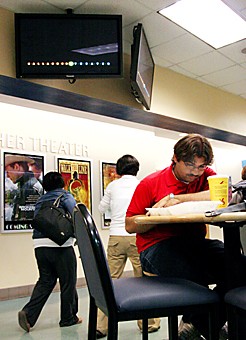Arizona Student Union staffers received overwhelming student support for a $40 fee that would cover expenses in the student unions, though a Wildcat survey found contradicting results.
The survey conducted by the Student Unions in January showed that out of more than 3,000 students, 72 percent were in favor of a fee if it went toward “”maintaining and enhancing student programs and events.””
These results sharply differ from the outcome of the Arizona Daily Wildcat, which randomly surveyed 100 students last week and found that 61 percent said the $40 fee is not justified – citing that students shouldn’t have to pick up the tab to offset Student Union expenses.
The fee would help rebuild the Student Union’s shrinking reserve fund, repair and renovate buildings and add more programs for students.
Starting in 2007, students would pay $20 a year. The fee would increase by $10 each following year until 2009,when it would reach the maximum $40, said Dan Adams, director of the Arizona Student Unions.
The fee would apply to undergraduate, graduate and professional students and would generate about $1.4 million a year by 2010.
The disparity between the two surveys may suggest a lack of information or awareness in the student community about the necessity behind the fee and how it would be distributed, Adams said.
“”The biggest challenge for students is understanding the complexity of the issue,”” Adams said.
Before students vote on the fee in a special election April 11 and 12, they need to understand how the financing at the unions works, Adams said.
The student unions are 97 percent self-supporting, Adams said, which means they receive little funding from tuition dollars.
“”So as our expenses keep rising, we need to identify a new source of revenue,”” Adams said. “”Doing nothing is not an option.””
The need for the student union fee stems from increases in employee benefits like health insurance and retirement, adding a burden worth $850,000 that the unions weren’t prepared for, Adams said.
To make up for these expenses among others, the unions have to borrow about $1 million over the next two years from its
reserve fund of about $1.5 million – a pool of money that Adams expects to run dry within the next two years if another revenue source isn’t found.
But to expect the entire student population to foot the bill for programs and expenses is not appropriate, especially considering that not all students go to the unions or use their services, said a media arts junior in the Wildcat survey.
“”Why would every student be expected to pay the union fee when not all students use the union?”” the student asked. “”Tuition is already expensive enough. This fee would be a rip-off for students like me who live off campus.””
How the money would be spent is also a concern to students, who said they wouldn’t approve the fee without knowing how they would directly benefit from it, according to the Wildcat survey.
Fifty percent of the fee would go toward the quality and number of programs and services like increasing club funding and offering free movie showings; 25 percent would be used for enhancements like buying new TVs and adding more eateries.
The remaining 25 percent would fund building expenses, like carpets, paint and a new roof for the Park Student Union.
By using the fee money to cover these expense areas, Adams said the unions would not have to keep borrowing from the reserve fund, nor would they have to increase product prices by 5 percent next year.
The Student Unions have a general breakdown of the items and expenses that will be purchased with the fee money, though they are still looking for student input to ensure the allocations are appropriate, Adams said.
The expenses on the budget were based off of the Student Union survey results about what students would be willing to pay for, Adams said.
The fee in 2007 would generate $700,000, allowing the union to purchase two big-ticket items, including $75,000 for plasma TVs and another $75,000 for computer upgrades.
In 2008, the fee would bring in a little more than $1 million, with the most costly expense ticketed at $100,000 for a DVD upgrade in Gallagher Theater. When the fee brings in the total $1.4 million, the union would spend the most money the first year on a $150,000 concert program, according to the budget.
But the purchasing habits of the Student Unions have left a sour taste in the mouths of some students, who said the unions should spend their money more wisely and stop purchasing items like plasma TVs before turning to a student fee.
“”It’s not up to students to alleviate budget problems in the student unions,”” wrote a business sophomore in the Wildcat survey. “”Before expecting us to fix the problem, perhaps the unions should stop unnecessary expenditures. Do we really need all those flat screen TVs?””
If the fee is approved, $10 from each student’s $40 fee will go to purchasing the TVs and other service enhancements like wireless access, more healthy food locations and outdoor seating.
“”These are the things that students said they want,”” Adams said.









